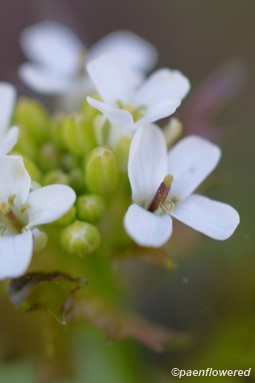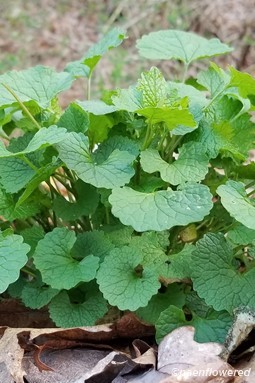Alliaria petiolata
A highly invasive herb from Eurasia originally imported as a salad green
Alliaria petiolata garlic mustard
Add to MyPlants View Locations
This is an alien, invasive species, introduced from Eurasia to America for use as a culinary spice, probably in the 1860s. It is a member of the mustard family. It has become widespread in disturbed areas, wood edges, open woods or roadsides and you should have no trouble finding many specimens of this weed.
Garlic mustard is one of the few invasive species that will grow in woodland wildflower habitats. I, therefore, have no sympathy for them. In some places it will dominate the understory and choke out native plants. If you see them growing, especially in a park or natural area, no one with any knowledge of plants will object if you pull them up by the roots. Just shake off the excess dirt and then break the plant in half. After it goes to seed, it is more difficult as you have to bag the head of the plant and dispose of it outside the woodlands. It is probably impossible to eradicate this species, but pulling it up at least provides some degree of control.
You should take care not to mistake this for other related native plants like spring cress or cut-leaf toothwort. The leaves of garlic mustard are stalked and sharply toothed and shaped like a triangle or heart. The other species have distinctly different leaves. When crushed Garlic Mustard has a distinct odor of garlic. The roots have the smell of horseradish. The plant can grow to a height of 1-3 feet. It is biennial; the first year it forms clumps of round-shaped, slightly wrinkled leaves. It flowers the second year in the spring, producing button-like clusters of cross-shaped white flowers. The flowers have four petals as is typical of the mustard family. These flowers have an unattractive odor, probably to attract midges and hoverflies.
As flowering progresses into early summer, the stem elongates into a spike-like shape that can look very weedy. It is either self-pollinated or cross-pollinated by a variety of insects. A single plant can produce hundreds of seeds in long 4-sided pods. Garlic mustard is classified as a noxious weed in the United States because it has few natural enemies and the local deer will not eat it. It is, however, not without some benefits. The flowers and leaves can be chopped up and used to flavor salads and sauces as they have a taste that is a combination of garlic and mustard. In France, the seeds are used directly to season food. They are best used when young. Thus if you are into wild foods, eating it is a good substitute for destroying it.
In Europe and America it is known by the local names of garlic root, hedge garlic, sauce-alone, Jack in the bush, penny hedge, and poor man's mustard.
Habitat & Range
Grows along forest edges, in forests, man-disturbed habitats and fields/roadsides.
Present throughout the state.
| EMP: | FACU |
|---|---|
| NCNE: | FACU |
Phenology
Flowers late April through June.
Alliaria petiolata garlic mustard
Synonyms: Alliaria officinalisAdd to MyPlants View Locations








Comments
Have you spotted this plant in your area? We'd love to hear about your experience! Share your comments or questions about the plant below. Comments are moderated before posting.